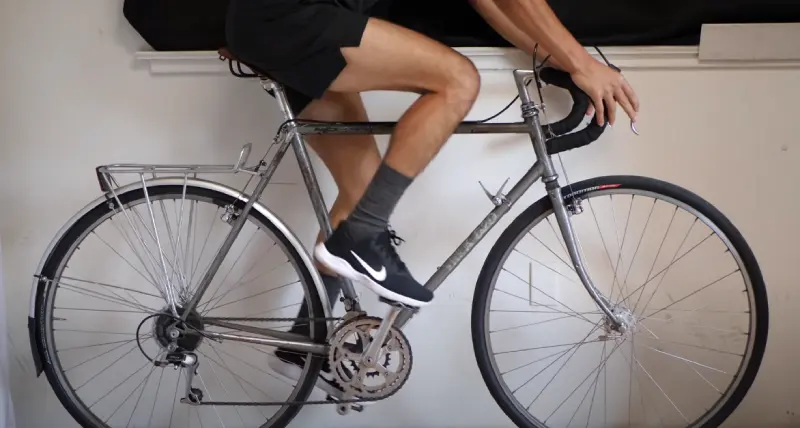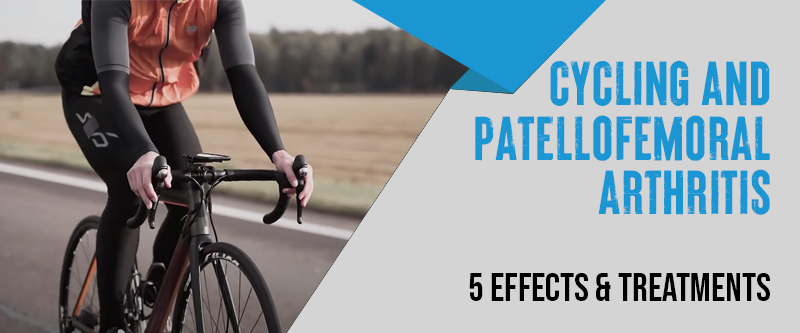Over 45% of cycling overuse injuries target the knees, a common occurrence given the sport. Patellofemoral arthritis stems from cartilage wear on the trochlear groove and patella underside. A common cycling injury is a patellofemoral pain syndrome or PFPS.
To manage cycling with patellofemoral arthritis, proper bike setup is crucial. This involves maintaining a pedal cadence of 90 to 120 revolutions per minute, adjusting seat height and position, and using foot support inserts. These adjustments ease knee strain and prevent PFPS during cycling.
In this blog post, we’ll explore complications, causes & symptoms of Patellofemoral Arthritis pain in cycling, along with tips and treatment to protect your joints while enjoying this fantastic activity.
Cycling With Patellofemoral Arthritis: 7 Safety Tips

While cycling can keep you fit and active, it can put a lot of pressure on your knee joints. Here are some potential risks of cycling while you suffer from Patellofemoral arthritis syndrome:
- Increased Risk of Joint Damage: The repetitive cycling motion can cause additional wear and tear on already damaged knee joints, leading to further damage and potential long-term harm.
- Joint Overload: Cycling can pressure your knee joint, leading to collaborative overload and further degeneration if you cycle too often.
- Increased Pain and Inflammation: Cycling with Patellofemoral arthritis can increase pain and inflammation in your knee, exacerbating your symptoms and leading to potentially severe discomfort.
- Risk of Injury: Cycling can increase the risk of joint injury, especially if you don’t use proper cycling techniques, have poor bike fit, or ride on uneven terrain.
- Decreased Mobility and Range of Motion: If you continue to cycle with Patellofemoral arthritis, you may experience a reduced range of motion and mobility in your knee joint, making it increasingly difficult to perform everyday movements.
Patellofemoral Arthritis When Cycling: 5 Causes
To effectively prevent and manage this condition, which often results in pain and discomfort, cyclists must understand the underlying causes of patellofemoral arthritis. Various factors can contribute to the development of patellofemoral arthritis pain, including:
- Improper Bike Fit: Improper bike fit is an extrinsic cause of patellofemoral arthritis.
- Muscle Imbalances or Weakness: Patellofemoral pain occurs due to weak or imbalanced hip and knee muscles.
- Overuse: Cycling excessively causes patellofemoral arthritis pain because the knee joint is overused.
- Trauma: Cycling can cause arthritis pain when the patella is injured or involved in an accident.
- Age: As we age, our joints naturally deteriorate, causing arthritis pain, including Patellofemoral arthritis.
Patellofemoral Arthritis from Cycling: 4 Symptoms
Patellofemoral arthritis arises when the cartilage beneath the kneecap (patella) deteriorates, resulting in friction and rubbing against the thigh bone (femur). Symptoms of cycling patellofemoral arthritis may include:
Pain and Stiffness in the Knee Joint
Pain and stiffness in the knee’s front can be experienced by those with patellofemoral arthritis, making it difficult to pedal with enough power to move the joint.
Difficulty Bending and Extending the Knee
Patellofemoral arthritis can cause inflammation and swelling in the knee, making bending and extending the knee complex. These symptoms can make cycling uncomfortable, resulting in a reduction in performance.
Knee Clicking, Grinding, or Popping Sensation
Patellofemoral arthritis is also characterized by clicking, grinding, or popping sensations in the knee, which can show cartilage degradation because of wear and tear on the joint.
Difficulty Walking Up or Down Stairs
Walking up and down stairs may become challenging as patellofemoral arthritis progresses, as the knee’s constant bending and straightening motion can exacerbate the pain.
Protect Your Joints while Cycling with Patellofemoral Arthritis: 7 Precaution Tips
Even with Patellofemoral arthritis, you don’t have to give up cycling. Cycling can improve osteoarthritis outcomes. Minimize your risk of injury by protecting your joints. Here are some preventive tips for cycling with Patellofemoral arthritis:
- Warming up and Cooling Down: For patellofemoral syndrome, focus on stationary biking. Before and after cycling, take time to stretch and warm up. This can reduce inflammation and joint pain, which is also good for hip arthritis.
- Start with a Quick Ride: 5 or 10 minutes at low resistance. Your endurance and intensity should be gradually increased as you progress. Exercise moderately intensely for 150 minutes a week (30 minutes, 5 times a week).
- Bike Adjustment: Make sure your bike fits your body and eases the pressure on your knee joints. You should work with a professional or experienced cyclist to get the right bike and fit.
- Use Appropriate Gear: Wear a knee brace or additional padding to support your knee joint and reduce the impact of cycling.
- Change Your Routine: Wait to cycle daily for long periods without resting. Switching up your training can also prevent further damage and joint pain.
- Muscle Building: Exercises targeting the muscles surrounding the knee joint can reduce joint stress and increase stability.
- Listen to Your Body: Cycling with Patellofemoral arthritis syndrome requires listening to your body. Take a break and allow your body to heal if you are experiencing increased pain, inflammation, or discomfort while cycling.
Patellofemoral Arthritis with Cycling Pain Management: 4 Techniques

Cycling techniques can ease some pain and make cycling more enjoyable. Here are a few ways to manage discomfort associated with Patellofemoral Arthritis while cycling.
Proper Bike Fit
Ensure your bike is fitted correctly to reduce Patellofemoral Arthritis pain while cycling. Here are some tips to ensure this:
- Your knee should be slightly bent during pedaling when you adjust the saddle height.
- Adjusting the saddle fore and aft, ensure your foot is positioned correctly on the pedal.
- Maintain a neutral spine position while cycling by adjusting the handlebar height and reach.
Change Your Cycling Technique
To reduce pain and improve performance, you must adjust your cycling technique if you suffer from patellofemoral arthritis. Consider implementing these changes:
- Steep terrain and hills should be avoided.
- Include flat surfaces that are moderately resistant.
- To prevent excessive knee strain, pedal consistently.
- For proper knee alignment, adjust the saddle height on your bike.
Intensity
Changing your Intensity can also help manage Patellofemoral Arthritis pain while cycling. The cadence measures how many revolutions per minute (rpm) your pedals make.
- The rhythm should range between 80 and 100 (RPM).
- Maintain a higher cadence on hills by using a lower gear.
- Avoid sudden bursts of acceleration or deceleration.
Pedal Stroke
Cycling with a good pedal stroke can also help reduce Patellofemoral Arthritis pain. Here are some tips to improve your pedal stroke:
- Focus on pushing and pulling evenly with a circular pedal stroke.
- Keep your feet in the correct position using pedals with few clips or toe cages.
- Don’t push too hard, and keep your pedals relaxed.
Patellofemoral Arthritis and Cycling: 2 Treatments
Evidently, PFPS isn’t self-limiting—it won’t resolve on its own. Seeking professional diagnosis and treatment is crucial; patients must take steps to address the issue. Empower yourself to manage your knee health effectively and ease pain and discomfort.
Stretching and Strengthening Exercises

You can reduce pain and improve knee function by stretching and strengthening your knees when you have patellofemoral arthritis. Here are some practical patellofemoral arthritis exercises to support your knee health:
- Low-Impact Exercise: Indoor cycling or recumbent biking can enhance knee strength without excessively pressuring the joint.
- Weight Management: Weight loss can significantly reduce knee pain and pressure.
- Quadriceps Strengthening: Extending your knees, squatting, wall sitting, and lunging can strengthen your quadriceps. These muscles support the
knee joint. - Hamstring and Glute Strengthening: Hamstring curls, bridges, and hip abductors can strengthen the hamstrings and glute muscles, supporting the knee joint.
- IT Band Stretching: By stretching the IT band, tightness and inflammation in the knee joint can be prevented.
- Physical Therapy: Physical therapy is beneficial for patellofemoral arthritis. Exercise can strengthen knee muscles, reduce pain, and improve mobility with the help of a therapist. Modalities like ultrasound, electric stimulation, and massage enhance the effectiveness of therapy.
Pharmacological Interventions
Pain can be managed effectively with pharmacological interventions, including NSAIDs like aspirin and ibuprofen.
- Topical Analgesics: Ointments and creams containing capsaicin or menthol can relieve temporary pain.
- Corticosteroid Injections: Injections of corticosteroids can reduce inflammation and provide long-term pain relief.
Conclusion
Cycling with Patellofemoral Arthritis can be a challenging experience; with the proper technique and guidance, enjoying the benefits of this fantastic activity is still possible.
The correct cycling techniques and protection of your joints are crucial to preventing injury and managing Patellofemoral Arthritis pain.
Physical therapy and regular exercise can strengthen your muscles and improve your flexibility, making cycling more comfortable and pain-free.
Cycling is a great way to stay healthy, and with the proper precautions, it is still possible to enjoy it, even with Patellofemoral Arthritis. We hope this blog post has been helpful, and we wish you all the best on your cycling journey.
FAQs
What Is The Life Expectancy Of A Patellofemoral Joint?
Patellofemoral syndrome typically takes 4-6 weeks for full recovery with adequate treatment and rest. The complexity of Runner’s knee means the underlying cause can vary among individuals. Seeking guidance from your physiotherapist to create a personalized recovery plan can expedite your healing process.
What Is The Best Way To Sleep With Patellofemoral Pain?
The tensing of your leg in bed can intensify discomfort and lead to sleeplessness. For a restful night, the optimal posture is lying supine (on your back). To enhance comfort, we recommend keeping the leg straight and slightly raised. This practice can aid in reducing inflammation.
Is Cycling Good For Lower Back Pain?
Cycling is an excellent, low-impact activity for people with lower back pain. By maintaining proper posture and ensuring the correct bike size and setup, cycling emerges as a beneficial recovery workout. It enables a robust return from injury, all while minimizing strain on the back.


